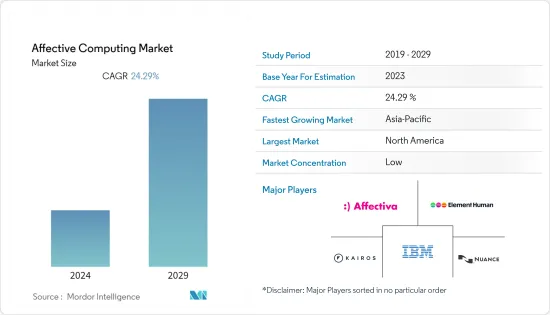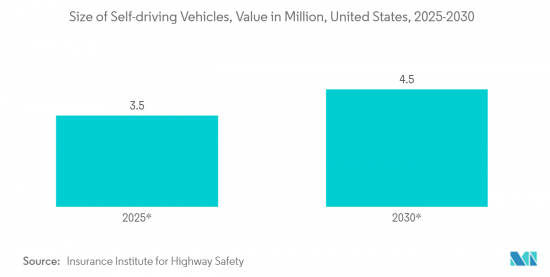PUBLISHER: Mordor Intelligence | PRODUCT CODE: 1404389

PUBLISHER: Mordor Intelligence | PRODUCT CODE: 1404389
Affective Computing - Market Share Analysis, Industry Trends & Statistics, Growth Forecasts 2024 - 2029

The Affective Computing Market size is estimated at USD 73.5 billion in 2024 and is expected to reach USD 218.2 billion by 2029, registering a CAGR of 24.29% during the forecast period.
The rise in demand for telehealth-related affective computing solutions and the rising need for socially intelligent artificial agents are some significant factors that are anticipated to propel the growth of the affective computing market during the projected period. Furthermore, the demand for effective computing is expected to develop due to the increasing use of wearable technology, increased internet penetration across industrial verticals, and global technical breakthroughs.
Key Highlights
- The affective computing market is developing due to the growing need for improved security in various industries and the demand for virtual assistants to detect fraudulent activities. Affective computing is used in multiple security applications, such as voice-activated biometrics, to restrict access to unapproved users. With the advancement in computing capacity, improved communication technology, and new solutions, such as AI, new possibilities are being realized, which will positively impact the market's growth.
- The emergence of affective computing has driven the growth of various applications. One of the significant areas in affective computing has been the design of computational devices that are proposed to showcase either natural emotional capabilities or capable of convincingly simulating emotions. For example, for speech impairments and emotionally handicapped people, Gestele, a prototype, was developed that adds to the affected people's emotions, gestures, or other forms of communication. The technology can also be used for personalization by adjusting light, type of music, and room temperature by detecting a person's mood, etc.
- Moreover, the increasing usage of robotics provides further incentives for implementing this technology. The recent advancement in robotics has led to an immense increase in the demand for artificially intelligent robots to behave politely and socially smartly. A report on World Robotics by the International Federation of Robotics (IFR) also showcased that worldwide industrial robot installations amounted to some 517,385 last year. It is prognosticated that by 2025, global industrial robot installations will amount to around 690,000. Additional feature inclusion, such as affective computing, can make these industrial robots much more acceptable and have better human-computer interaction.
- In its present technological capabilities, AI can support three essential business needs: automation of business processes, gaining insight through data analysis, and engaging with customers and employees. The third level requires cognitive engagement. Cognitive insights offered by machine learning differ from traditional analytics and require higher-level data. Due to such factors, these solutions are expected to improve further. Vendors are expected to form strategic partnerships with the end users to use the data for development purposes and offer them comprehensive solutions and services.
- Moreover, various organizations are engaged in innovations in applying affective computing (also called Emotional AI), which is expected to drive market growth during the forecast period. For instance, in August 2022, At the Massachusetts Institute of Technology (MIT), an innovative team used emotional AI to enhance people's mental well-being and general quality of life. Recent research from the MIT Media Lab's Affective Computing Research Group presents empirical proof that empathic artificial intelligence (AI) machine learning may mitigate the negative impacts of rage on human creative problem-solving.
- Affective computing market growth is anticipated to be hampered by issues with technical compatibility and high implementation costs, among other essential considerations. Implementing emotional computing requires a significant upfront investment, and delay in practical applications limits industry expansion. The system's expensive costs and difficulty comprehending user behavior further limit the market's development.
- The emergence of the COVID-19 pandemic significantly affected the affective computing industry, as people became more concerned regarding their health and safety during the lockdown measures. The rapidly increasing COVID-19 infections also gave rise to the usage of Al-based monitoring equipment, detection equipment, and advanced vaccination machines, among others.
Affective Computing Market Trends
Rising Technology Adoptions in Various Industries such as Automotive
- Currently, some of the most widely used effective computing technologies and solutions are found in the automotive sector. The majority of market participants offer at least one good or service geared toward automobile applications. In the automotive industry, affective computing is frequently used to create Advanced Driver-Assistance Systems (ADAS).
- The two categories of ADAS functions are comfort functions and security functions. The comfort feature is designed to warn the driver by causing alerts like flashing lights, sounds, sensations, or light steering recommendations. In the event that the driver does not respond to a potentially hazardous scenario, the security feature is designed to intervene within the car itself. Brake preloading, seatbelt installation, hood pulling, automatic braking, and avoidance steering are examples of possible maneuvers.
- By notifying and warning the drivers, the key effective computing applications in the automotive industry also aid in reducing accidents. As per the WHO (World Health Organization), it is estimated that 20-50 million people suffer from fatal injuries in traffic accidents each year, killing around 1.3 million people. Pedestrians, motorcyclists, and cyclists are among the most at-risk road users, accounting for more than half of all fatalities. The 2030 Agenda for Sustainable Development sets lofty goals for reducing road traffic injuries, including effective computing technology in the automobile industry, using proven methods to lower the risk of accidents and fatalities.
- Moreover, to track and react to the actions and feelings of drivers and passengers, Eyeris and Affectiva put cameras in the automobiles. Driver drowsiness is monitored via emotional technology. It can also be used to start alarms, postures, and positioning, connect to intelligent seats to increase passenger comfort, prevent driving rage, impatient accidents, etc.
- Further, according to the Insurance Institute for Highway Safety, self-driving cars in the United States are anticipated to reach 3.5 million by 2025 and 4.5 million by 2030. Also, to incorporate Affectiva's automotive technology into SmartEye's ground-breaking interior sensing solution, the company bought Affectiva in 2021. These insights enable the Automakers to enhance safety features to meet Euro NCAP standards. Such a significant rise in technology adoption in the automotive segment would create considerable opportunities for various effective computing solution providers.

North America is Expected to Hold the Largest Market Share
- The North American region has been one of the largest markets for affective computing globally, majorly led by the United States. The area comprises some of the most active research organizations working toward developing innovative, effective computing devices capable of serving several end-user applications, especially in the healthcare, market research, and automotive sectors. Moreover, with the improved infrastructure for artificial intelligence and other advanced technologies, the region consists of various infrastructures that are primarily required to deploy effective computing.
- Also, various organizations actively research new technologies in affective computing. For instance, in September 2022, Researchers from Michigan University's CSE department identified one of their papers as one of the top five to appear in IEEE Transactions on Affective Computing. The researchers suggested new approaches for expanding the scope of representations of speech for emotion to boost recognition performance across datasets.
- Moreover, research organizations such as MIT have also been concentrated in the region, conducting multiple research projects, including Affective Response to Haptic Signals and Automatic Stress Recognition in Real-Life Settings, among others. The university has a department in the MIT media lab called the Affective Computing Group, which majorly researches new methods of communicating affective and cognitive states and inventing personal technologies for improving self-awareness of affective states, which is further anticipated to increase the investments in the region driving the growth of affective computing.
- Over the past decade, several companies emerged from the Affective Computing Group of MIT Media Lab (research laboratory at the Massachusetts Institute of Technology). For instance, Affectiva Inc., a major affective computing company, has established its footprint in the global market. The company has raised over USD 60 million since its inception.
- Many Canadian businesses are concentrating on developing new gesture and speech recognition solutions. The Canadian company GestSure Systems offers a gesture software interface that allows doctors to access patient records on computers in locations other than sterile operation rooms. Also, the company provides hardware that serves as a USB bridge to interchange CT and MRI data with an already installed hospital PC using Kinect. Surgeons can navigate images without using their hands since mouse commands are translated into gestures.
- Additionally, a Canadian-based company, Baanto, has developed ShadowSense Technology, an optical positioning-based touch technology that can be used on multiple touchscreen displays. In March 2022, the company recently announced 27-inch night vision imaging system samples for high-performance military applications.
Affective Computing Industry Overview
The competition among the existing market players in the affective computing market is high, making them prone to aggressive acquisition strategies to capture the market and enhance the first mover's advantage with new solutions. Affectiva Inc., IBM Corporation, Nuance Communications Inc., Element Human Ltd., and Kairos AR Inc. are a few prominent players with a significant share of the market.
In June 2022, Nuance Communications announced a partnership with SCIENTIA Puerto Rico, Inc. to expand access to Nuance's Dragon Medical One speech recognition solution for the island's physicians and nurses to improve clinical documentation quality and patient outcomes while reducing administrative workloads that contribute to clinician burnout. Also, in June 2022, Aural Analytics, Inc., a prominent player in clinical-grade speech analytics, announced a partnership with Koneksa, a player in digital biomarker development, to further strengthen its platform and research capabilities using Aural Analytics' technology, Speech Vitals.
Additional Benefits:
- The market estimate (ME) sheet in Excel format
- 3 months of analyst support
TABLE OF CONTENTS
1 INTRODUCTION
- 1.1 Study Assumptions and Market Definition
- 1.2 Scope of the Study
2 RESEARCH METHODOLOGY
3 EXECUTIVE SUMMARY
4 MARKET INSIGHTS
- 4.1 Market Overview
- 4.2 Industry Attractiveness - Porter's Five Forces Analysis
- 4.2.1 Bargaining Power of Suppliers
- 4.2.2 Bargaining Power of Consumers
- 4.2.3 Threat of New Entrants
- 4.2.4 Threat of Substitutes
- 4.2.5 Intensity of Competitive Rivalry
- 4.3 Assessment of the Impact of COVID-19 on the Market
5 MARKET DYNAMICS
- 5.1 Market Drivers
- 5.1.1 Increased Automation in Contact Centers
- 5.1.2 Increasing Adoption of Cloud-based Solutions and Online Solutions
- 5.1.3 Rising Technology Adoptions in Various Industries such as Automotive
- 5.2 Market Challenges
- 5.2.1 High Approval Times in Healthcare
- 5.2.2 Privacy and Security Concerns
6 TECHNOLOGY SNAPSHOT
- 6.1 Speech Recognition
- 6.2 Gesture Recognition
- 6.3 Facial Recognition
- 6.4 Other Types
7 MARKET SEGMENTATION
- 7.1 By Component
- 7.1.1 Hardware
- 7.1.1.1 Sensors
- 7.1.1.2 Cameras
- 7.1.1.3 Storage Devices and Processors
- 7.1.1.4 Other Components
- 7.1.2 Software
- 7.1.2.1 Analytics Software
- 7.1.2.2 Enterprise Software
- 7.1.2.3 Facial Recognition
- 7.1.2.4 Gesture Recognition
- 7.1.2.5 Speech Recognition
- 7.1.1 Hardware
- 7.2 By End User Industry
- 7.2.1 Healthcare
- 7.2.2 Automotive
- 7.2.3 Retail
- 7.2.4 Other End User Industries
- 7.3 By Geography
- 7.3.1 North America
- 7.3.2 Europe
- 7.3.3 Asia-Pacific
- 7.3.4 Rest of the World
8 COMPETITIVE LANDSCAPE
- 8.1 Company Profiles
- 8.1.1 Affectiva Inc.
- 8.1.2 Element Human Ltd
- 8.1.3 Kairos AR Inc.
- 8.1.4 Nuance Communications Inc. (Microsoft Corporation)
- 8.1.5 IBM Corporation
- 8.1.6 Gesturetek Inc.
- 8.1.7 Nemesysco Ltd
- 8.1.8 Realeyes Data Services Ltd
- 8.1.9 audEERING GmbH
- 8.1.10 Eyesight Technologies Ltd
- 8.1.11 Emotibot Technologies Limited
- 8.1.12 Amazon Web Services Inc.
9 INVESTMENT ANALYSIS
10 MARKET OPPORTUNITIES AND FUTURE TRENDS




